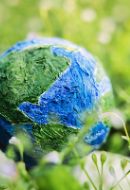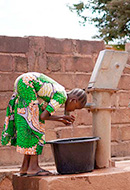How we pollute the environment
Little things you do that pollute the environment, even though you (might) not realise they do
Leaving the tap running while you brush your teeth, drinking bottled water and throwing chewing gum on the ground. These, and other everyday habits show that we are sometimes unaware of how we pollute the environment. Learn about the small daily habits you can change to benefit the planet.




Not long ago, we thought that nature was not only wise, but also indestructible. We believed it could overcome, volcanoes, ice ages and meteorites as destructive as 10 billion atomic bombs. However, in the 21st century we are faced with images of a planet being choked by oceans of plastic, with melting icecaps and parched forests becoming deserts. The evidence is there: the planet is on the edge of an abyss and we are going down with it.
How we pollute the environment
We are breaking a terrible record, one that has never occurred in the history of mankind. According to Intergovernmental Science Policy Platform on Biodiversity and Ecosystem Services (IPBES), more than one million species of plants and animals are threatened with extinction as a result of human activities. Overexploitation, climate change, pollution, the introduction of invasive species and land use change are causing their disappearance, which is hundreds of times faster than the natural extinction process. One consequence of this process is the domino effect, which could lead to an even more accelerated disappearance of species and even entire ecosystems.
Experts now believe that this unsustainable use of land, water and energy has taken us through the sixth mass extinction in history, as the World Wildlife Fund (WWF) explains in an article. A total of 40% of the Earth's land surface has been converted for food production. In addition, 90% of global deforestation and 70% of the world's freshwater use are attributed to agriculture. These actions alter habitats where plant and animal species live, leading to their disappearance.

What is electric mobility?
Electric mobility has become the mobility promise of the future.

Biodiversity protection in Iberdrola
All projects aim to minimize their impact on flora and fauna.

Earth Day 2024
The 54th World Earth Day 2024, is under the slogan "Planet vs. Plastics".

What is water security and how is it threatened by climate change?
ONU: By 2030, the Earth will have a water deficit of 40%.
The key figures of global warming

Temperature of the planet
Due to mankind’s activities, in 2023 the temperature of the planet was already 1.36ºC higher than it was before the industrial revolution

Sea level
The global sea level has risen 20 cm since 1880 and it is expected to rise an additional 30 - 122 cm by 2100

Global CO₂ emissions must be reduced to zero by 2050 to limit heating to 1.5 ºC

A bold climate action could generate at least 26 billion dollars in profits by 2030

Paris Agreement
It covers a third of the CO₂ reductions needed to keep the world below 2°C

Energy industry
It will create more than 18 million jobs related to sustainable energy by 2030
10 everyday activities that pollute
We are all responsible for global warming. We habitually use things that pollute the environment without knowing it and we need to avoid them at all cost. For example:
 Using aerosol deodorants
Using aerosol deodorants
Aerosols damage air quality, although, according to a 2018 article in scientific journal Nature Communications, their effects on temperature vary according to the part of the world where they are used.
 Bottled water
Bottled water
Plastic water bottles take 500 years to break down and they release microparticles which are dangerous to health.
 Throwing chewing gum on the ground
Throwing chewing gum on the ground
Chewing gum consists primarily of neutral plastic and, as well as littering the streets, it chokes and kills many birds who mistake it for food.
 Washing with the tap running
Washing with the tap running
Scientists from North Carolina State University (USA) Have calculated that we would save over 1,400 litres per person per month just by turning off the tap when we wash our hands and brush our teeth.
 Eating foods that contain palm oil
Eating foods that contain palm oil
Chewing gum consists primarily of neutral plastic and, as well as littering the streets, it chokes and kills many birds who mistake it for food.
 Leaving cigarette butts on the beach
Leaving cigarette butts on the beach
This is the most commonly found waste on the coast, they take up to 10 years to break down and release contaminating metals.
 Throwing disposable wipes down the toilet
Throwing disposable wipes down the toilet
These do not break down like toilet paper and they are responsible for most blockages in water treatment plants and sewers.
 Releasing helium balloons into the air
Releasing helium balloons into the air
This is extremely dangerous to birds, fish and other marine animals that can choke if they eat them by mistake.
 Throwing batteries in the rubbish
Throwing batteries in the rubbish
They contain mercury — one of the most toxic metals in the world — and take 500 to 1,000 years to break down. Just one battery can contaminate up to 3,000 litres of water.
 Throwing away plastic six-pack ring carriers without cutting them up
Throwing away plastic six-pack ring carriers without cutting them up
These plastic rings trap animals like fish and turtles, causing mutilation, malformation and even death.
Actions that protect the environment
Now we are aware of how we are damaging the environment, we need to find solutions and change our habits. Here are some suggestions from the United Nations (UN):
 Separate your waste: don't mix your household waste, separate everything into different containers.
Separate your waste: don't mix your household waste, separate everything into different containers.
 Recycle and reuse: stop using single-use plastics and always choose packaging and items that can be reused several times. Before you throw something away, think whether you can give it a second use.
Recycle and reuse: stop using single-use plastics and always choose packaging and items that can be reused several times. Before you throw something away, think whether you can give it a second use.
 Save energy: make use of natural light, install LED bulbs, switch off lights you don't need, adjust your thermostat and air conditioning.
Save energy: make use of natural light, install LED bulbs, switch off lights you don't need, adjust your thermostat and air conditioning.
 Eat organic food: buy fruit and vegetables free from fertilisers and other pollutants.
Eat organic food: buy fruit and vegetables free from fertilisers and other pollutants.
 Turn off taps: ensure they are not dripping when you finish washing up or washing.
Turn off taps: ensure they are not dripping when you finish washing up or washing.
 Use sustainable means of transport: walk, pedal or user public transport whenever you can.
Use sustainable means of transport: walk, pedal or user public transport whenever you can.
 Do not use single-use bags: use cotton bags instead of plastic and paper ones.
Do not use single-use bags: use cotton bags instead of plastic and paper ones.
 Fill your house with flowers: plants and trees produce oxygen and are essential to nature.
Fill your house with flowers: plants and trees produce oxygen and are essential to nature.




